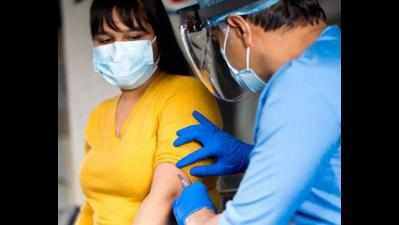- News
- City News
- mumbai News
- Mumbai: Women on top in Gondia and Bhandara vax drives
Trending
This story is from June 17, 2021
Mumbai: Women on top in Gondia and Bhandara vax drives

Representative Image
Mumbai: Bucking the trend of gender disparity widely seen in the state and most parts of the country, two Vidarbha districts, Gondia and Bhandara, have vaccinated more women than men.
In Gondia, 3,347 more women have been vaccinated; in Bhandara, 2,567 more women have taken the shots than men till Wednesday (see box).
In all but these two districts, more men have got inoculated, according to CoWin data.Overall, in Maharashtra, men account for 54% of the total number of people inoculated. In absolute numbers, over 16 lakh more men have taken the vaccine in the state.
The trend in Gondia and Bhandara has come as a pleasant surprise as the gender disproportion in some of the other districts in the region has been massive. In nearby Gadchiroli, for instance, which has a comparable population, nearly 13,000 more men have got the vaccine. In Chandrapur in Vidarbha too, almost 24,000 more men have taken the vaccine.
Dr Nitin Kapse, Gondia’s district health officer, said, the vaccination awareness programmes were designed for both men and women. “We don’t know why such a trend has emerged. But we have intensified vaccination and are targeting village by village,” he said, adding that resistance was a big factor. “Once we have covered those who are willing, we will intensify the drive to reach those who are hesitant,” he added. Both these districts have vaccinated nearly 50% of the population above 45 with one dose.
Sunanda Vasashankar, an ASHA worker who has been working in Bhandara city, believes there could be multiple reasons, ranging from hesitancy to vaccine shortage. “The answer I repeatedly hear from women is that they don’t want their husbands to suffer any side-effects since it will keep them away from work. The few men that we convince sometimes get discouraged looking at long queues or hearing of shortages,” she said.
Madhuri Mathurkar, Bhandara’s additional district health officer, said more men were affected in the second wave and have to wait at least three months to get vaccinated. Also, women who stay at home often get vaccinated since ASHAs keep prodding them, she said. “Earlier, we used to vaccinate at primary health centres but now we have taken the drive to villages,” she said.
A state official said gender disparity should be seen relatively. “Maharashtra has about 7-8% more men than women hence, more men are getting vaccinated. But the gap is wider in some districts no doubt,” he said.
In Gondia, 3,347 more women have been vaccinated; in Bhandara, 2,567 more women have taken the shots than men till Wednesday (see box).
In all but these two districts, more men have got inoculated, according to CoWin data.Overall, in Maharashtra, men account for 54% of the total number of people inoculated. In absolute numbers, over 16 lakh more men have taken the vaccine in the state.
The trend in Gondia and Bhandara has come as a pleasant surprise as the gender disproportion in some of the other districts in the region has been massive. In nearby Gadchiroli, for instance, which has a comparable population, nearly 13,000 more men have got the vaccine. In Chandrapur in Vidarbha too, almost 24,000 more men have taken the vaccine.
Both Gondia and Bhandara are among districts with a better sex ratio -- 996 and 984, respectively. But, according to P Arokiasamy of the International Institute of Population Science (IIPS), a balanced sex ratio is unlikely to have such an outcome. “It could be local factors such as the administration’s handling of the drive,” he said. However, officials themselves are surprised and are looking for answers.
Dr Nitin Kapse, Gondia’s district health officer, said, the vaccination awareness programmes were designed for both men and women. “We don’t know why such a trend has emerged. But we have intensified vaccination and are targeting village by village,” he said, adding that resistance was a big factor. “Once we have covered those who are willing, we will intensify the drive to reach those who are hesitant,” he added. Both these districts have vaccinated nearly 50% of the population above 45 with one dose.
Sunanda Vasashankar, an ASHA worker who has been working in Bhandara city, believes there could be multiple reasons, ranging from hesitancy to vaccine shortage. “The answer I repeatedly hear from women is that they don’t want their husbands to suffer any side-effects since it will keep them away from work. The few men that we convince sometimes get discouraged looking at long queues or hearing of shortages,” she said.
Madhuri Mathurkar, Bhandara’s additional district health officer, said more men were affected in the second wave and have to wait at least three months to get vaccinated. Also, women who stay at home often get vaccinated since ASHAs keep prodding them, she said. “Earlier, we used to vaccinate at primary health centres but now we have taken the drive to villages,” she said.
A state official said gender disparity should be seen relatively. “Maharashtra has about 7-8% more men than women hence, more men are getting vaccinated. But the gap is wider in some districts no doubt,” he said.
End of Article
FOLLOW US ON SOCIAL MEDIA











